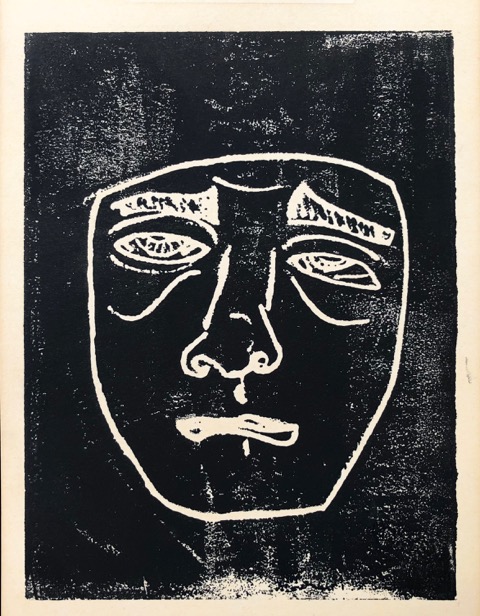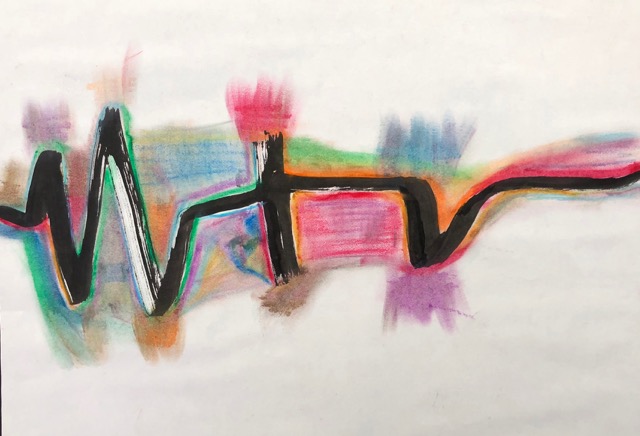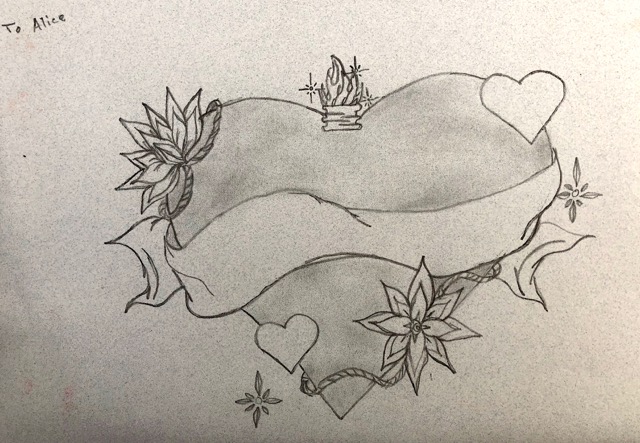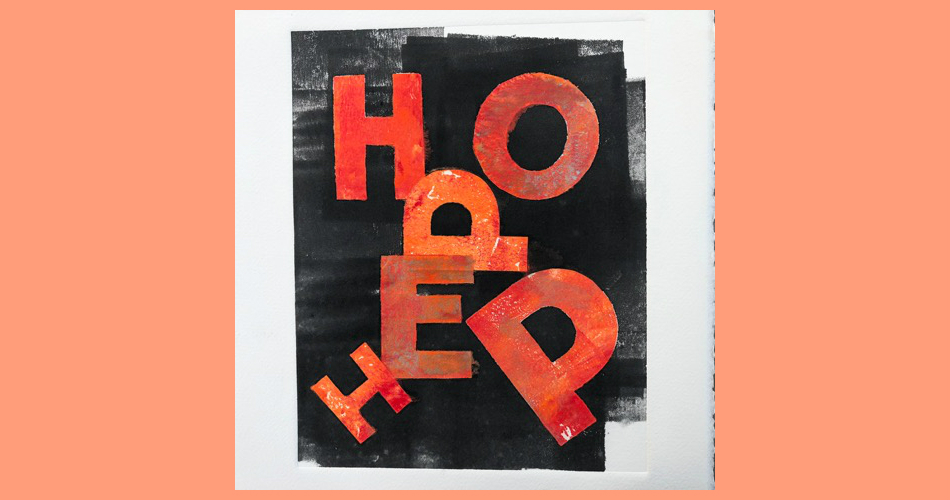Header image: “Hope,” print by Alice Buckley. All other images of artwork by students in Alice’s classes in Detention and Dolores Mission. All images by author.
Everyone has their own opinions and views but I believe that art can be used to wash away our ignorance, greed, and hatred resulting in the cultivation of compassion, peace, and kindness. –Participant, Prison Arts Collective
This statement embodies why I became an artist. It is why I have dedicated so much of my career to shifting, altering, and ideally breaking the boundaries between those who have access to the healing and invigorating power of art and those who do not. But it might surprise you to learn where I heard these words. I was in the visiting area of a high security prison at the edge of California, near the border with Mexico. It was the final day of a six-month arts facilitator training that I teach to those that are incarcerated so that they can pass along their skills in the arts to their peers as mentors and teachers. The man that shared this thought was a student in our class and graduated that day.
His statement gets right to the heart of why art matters. Yet it’s so distant from what is often reported about the field of contemporary art — auctions and price points, museums and controversies — that it becomes something else. I think that the art he describes, the art that is a means to transform and express, heal and connect, gets closer to art in a larger sense, art that can be traced through time to the earliest humans.
People often ask how I came to be involved with art in prisons and I rarely have a good or ready answer. Our program participant’s comment gives shape to why I stay involved, but the reason I got involved to begin with goes back to my mother, Alice Buckley. About 20 years ago, after my father, her husband, passed away, and she retired from a successful real estate career, she began to volunteer to teach art to teens at Dolores Mission Alternative School in Boyle Heights. Her students had been removed from nearby public schools for their involvement with gangs, drugs, or truancy. She talked about how some folks she knew wondered why she would make the drive from her condominium in Hancock Park to East LA to teach kids that were often considered to be bad or problems; but that’s the thing, she never saw them that way. What she saw was people, kids, who had lives and stories and troubles all their own. She had a sense from her experience as a mother and as an artist that spending time creating — using the imagination and learning something new — was a valuable pursuit, and she was right. The kids came to love her and the art classes. A gentle sense of community formed around art.
Not long afterwards, Alice — or Miss Alice, as some called her — began to volunteer twice a week at Central Juvenile Hall with Catholic Detention Ministries. She would talk to kids, spend time with them, and really listen and engage. She didn’t give advice so much as provide a space for the kids to see aspects of themselves that they might not have recognized, their potential for empathy and imagination, their curiosity and courage. She would share books and stories and ask questions. Eventually, she started an art class here, too. We talked often about her work and I had the chance to go with her about a dozen or more times over the years. Usually, I went on holidays and would help her and other volunteers pass out small paper bags of chips and candy provided by the ministry. When we were done, she nearly always had one more stop, to drop off a book or drawing pad, something one of the kids had asked for or that she thought he or she would enjoy, so we would make additional trips to other units. She was always kind with the officers and often knew them by name. She would talk with the officers and ask if it was okay to drop off the extra item. She preferred to give it directly to the youth, so that she could check in and say hello, and they usually allowed her to do that.

I remember one time we visited and then went to deliver a book. The boy receiving it was in a room by himself and had not been allowed to attend the mass and celebration but they allowed her to bring him the book. We sat and talked with him for a few moments. He was about 14 and his family was in another state. Here he was locked up in California on Christmas, a kid alone. Mom saw this situation and that he needed a little attention and time. She listened to his sad story and asked quietly if he had been able to talk to his mother. They chatted for a bit before our time was up. He was clearly sad but smiled shyly and thanked her for the book and visit.
We live in a punitive society where it is easy for some to hear this tale and think, well, he did something to deserve to be there, or that he needs to be locked up, or something else to justify the sad fact of a kid alone in a cell on Christmas with no family. But, at 14, how much of what he did was pre-meditated and understood? What had he experienced or lacked that led to the incident? These vital questions form the murky and difficult territory that stumps researchers and institutions and leaves many Americans seeking safer ground in the black and white dichotomy of good and bad. Mom saw the gray area, she recognized the complexities and we would discuss them. I was fierier in my opinions and, as she did with the kids, she listened; while she stayed up to date on all the issues and laws, more so than most, she always chose to focus her energy on the children and circumstances — on finding ways to help and implementing them.
I am fortunate that my parents encouraged us to question and to recognize that the world is complex and layered. My siblings and I grew up with a big sign that my dad had asked an architect friend to draft for him that read simply: “THINK.” This is what art offers — potentiality, the transformative capacity of thought and imagination — and it is what mom offered, too. Through art, books, dialogue, and other means, she sought to expand the vistas of these kids on the edges, kids locked up or at risk of being locked up.
I have spent my whole life as an artist and received two degrees in the field. I have also taught art in various situations and overwhelmingly I have chosen to teach kids and teens and young adults in neighborhoods very similar to Boyle Heights. I value my education but I learned more about the power of art from my mom and from the many kids, teens, and adults I have had the pleasure of teaching over the years than I did in the classroom. In graduate school, I remember telling mom about this or that struggle I was having with some theoretical aspect of contemporary art and criticism. She would listen and encourage while continuing to quietly make her artwork and support the kids.

In 2013, as a new faculty member at California State University, San Bernardino, I got a call from the men’s prison in Chino asking about bringing an art program there. At the time, I didn’t hesitate to say, “Yes!” because I knew it was possible and important; my mom had shown me that. Not long afterwards, I visited the prison with a group of students and we set up an eight-week pilot art program that has since grown into the sprawling Prison Arts Collective, a large part of our Community-based Art project that facilitates dozens of college students and recent alumni in teaching weekly art classes to hundreds of incarcerated men and women in eight prisons throughout California. Currently, we are in the first year of a three-year contract with Arts in Corrections, an initiative of the California Arts Council and the California Department of Corrections and Rehabilitation that will expand the work to 12 prisons through 2020. The men and women in our classes tell us so often that art is the only space where they can feel free.
As our program grew, my mom asked about it and became a valuable mentor, sounding board, and supporter. On a few special days, she came with me to the prison in Chino. I was always eager to show her what we had created, but no one was more delighted to see her than the nearly 80 men in prison blues that watched this woman, through her late 70s and early 80s, walk across the vast prison yard, with barbed wire fences and a dirt track, to the gym. I remember that she was as free as if ambling through a garden, smiling and talking with our young teachers and with the officers. Once in the gym, she chatted about art with participants young and old. The first time she visited, one of the younger men recognized her, “Alice?” He remembered her from juvenile hall. Every time thereafter, she made a point to take time to talk with him whenever she visited. She supported our growing program in many ways, donating reams of colorful tissue paper for a craft class, purchasing art from our shows, and donating funds so that every incarcerated artist could receive a book from our exhibition.
I already knew that art could be a lifeline — it has saved me many times over the years — and I understood the power of images, words, and engaged dialogue to change and empower, to comfort and connect. But it was my mom that showed me both the why and the how of reaching into the tightest dark spaces with the particular light of art.
In the first hours of January 7, 2018, I held her hand as she slipped from this world. She was in a hospital bed, unconscious, after a brief and intense battle with the flu. What followed was heartbreak and searing pain. But something else came in the wake of her death, an outpouring of love and grief from so many walks of life. Of course our family and her friends grieved, but so many others share our pain. The day she died, because she passed in the early hours in that very long day, my siblings called our family and I made calls to others that loved her. I talked to a young man that she met in juvenile hall and had remained in touch with over the years, as he was transferred from facility to facility and eventually got out. “I am going to write a book and dedicate it to her,” he said through stifled tears, “because she brought me books and she believed in me.” I talked to current and former chaplains, a fellow volunteer, a woman that worked for and befriended her; I talked to artists from East LA whose work she had purchased and careers she had nurtured. I spoke and listened, in English and Spanish, and often through tears. It was beautiful and sad and comforting and we cried together.
When we shared news of her death at the prison she had visited with me, one of the men incarcerated there wrote what so many feel: “I always found Alice to be such a joy to be around. She spoke to my heart when she spoke. She was my grandmother, my mother, my friend. She always made me feel heard and that whatever I created artistically was special to her. This inspired me to dig deeper and to just be myself. I will do my best to give to others what Alice gave to me. This is the very essence of love and community.”
Inside a prison, the inmates and officers are typically on very different planes, so it has a special significance that a correctional officer responded with a similar tribute, writing, “From the first time Annie introduced Alice as her mom, I felt that I had a new mom as well. What a great example she has been for so many people, including me.”
As I sit and write this story, both an origin tale and a tribute, tears come and go across my cheeks. On the table next to me is a thick stack of letters and cards from prisons and detention halls, written by so many of the youth that mom met and remembered and corresponded with over the years; in some cases it seems that she the only person to do so. The letters are a testament to the power of connection and what we have the capacity to do when we choose to find ways to make a difference rather than reiterating all the things that are wrong with the world. I perused the letters and they all started in the same way: “Dear Alice, how are you?”

They ask after her family and wish her well. They thank her for writing, for remembering them, and often thank her for a fun or creative card that she sent. From there, they share what they are up to, as one does in a letter, and the array of human tragedy — isolation, fear, abuse, missing and broken families, loneliness — is relayed in handwritten words as calmly as if sharing the weather. Their directness is poignant, on the one hand, painfully communicating the normalcy of these traumas and, on the other, encapsulating a sweet testament to the caring bond she formed with each youth, ushering them gently towards the wellspring of hope through art, books, and words.
After updating her on his particularly heartbreaking story of incarceration, drugs, violence, more incarceration, a mental hospital, and blinding uncertainty, one boy shares bluntly, “Alice, I’m now crying. Well I hope you’d be able to write back.” Another boy writes that he can’t believe she saved the palm cross he made for her at Easter. I can, and it makes me smile. In fact, I saved it, too; the palm cross she kept with the letter is in my home now, nestled in the felt pocket of a fabric bear on a makeshift altar.
A girl from her art class became a pen pal and remembers that the class helped her to relax and relieve stress. Relaying a recent family struggle, the girl adds that, “Art is my coping skill. I try to keep myself busy drawing whenever I get free time.” Near the end, she asks in the letter, “I know it’s random, but will you be my mentor? I’d be honored if you’d guide me through life on the outs the way you have continued to guide me even while detained.” She also asks for stamps, saying that mom’s letters inspired her write to other kids that are locked up.
We never know the impact that our actions will have, the ripples our life will leave. I am grateful to have had a mother that inspired me and so many others in the vital art of cultivating compassion, peace, and kindness.


